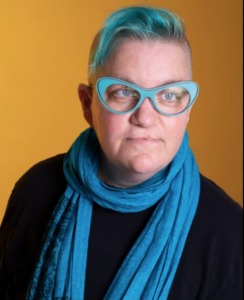The Long Shadow of Near Future Fiction
By Sage Tyrtle
 Near future speculative fiction has always felt possible to me in a way that spaceships and dragons don’t. I mean, don’t get me wrong, I love reading about spaceships and dragons too, but near future feels… well, near. Our planet, with our laws, our history, except — BOOM. That one thing. That one difference that makes the story feel like it could happen in my lifetime.
Near future speculative fiction has always felt possible to me in a way that spaceships and dragons don’t. I mean, don’t get me wrong, I love reading about spaceships and dragons too, but near future feels… well, near. Our planet, with our laws, our history, except — BOOM. That one thing. That one difference that makes the story feel like it could happen in my lifetime.
The first near future book I ever read was Margaret Atwood’s The Handmaid’s Tale, in 1986, when I was fourteen years old. I picked it up because the cover looked like a fantasy book, a woman in a gown next to a castle wall. The first page made it obvious I’d misunderstood, but by then I didn’t care. I was hooked. It was our world, but not. Our rules, but not. I read the book from cover to cover and was floored. It had never occurred to me that this genre existed, and I wanted more.
A year later I re-read The Handmaid’s Tale and found it just as scary as I did the first time. For me, near future emotions are bigger, more effective, more compelling. The beginning of Atwood’s novel, when the protagonist is trying so hard to get across the Canadian border to safety, haunted me. That image. How close she is to being all right before everything goes wrong. Eighteen years later, I crossed that Canadian border myself. I’ve lived in Canada for many years now, and I’m not sure I’d be here without that book.
That, for me, is the power of this genre. It’s a way to talk about real issues (like bodily autonomy) in a way that even a fourteen-year-old who loved Duran Duran and Sweet Valley High books could access. An author sat down one day and wrote a book that has had a ripple effect on me and millions of others since 1986. That’s a long shadow. A good shadow.
Curious to learn more? Here are a few near future books I’ve loved:
The School for Good Mothers, by Jessamine Chan – After being deemed unfit, a mother is subjected to a surveillance state re-education program with AI children.
Station Eleven, by Emily S. John Mandel – You’ve probably heard of this one, because of the pandemic. I read it before 2020 and again after and loved it both times in completely different ways. This book is about a traveling theater troupe in a post-pandemic world.
The Children of Men, by PD James – What if babies stopped being born? What does the last generation, now in their twenties, look like? This book captures one of my favorite aspects of near future — how one change to our current reality effects every single thing in the world.
The Need, by Helen Phillips – It is REALLY hard to talk about this one without spoiling it, so I’ll just say this book is about the dualities of motherhood, in the most devastatingly speculative fiction way.
Space Opera, by Catherynne M. Valente – And because near future can be joyful too, this wonderful romp through a galactic Eurovision contest had me laughing out loud.
Explore Near Future Fiction with Sage
TUESDAY, MARCH 4: “Speculative Fiction: Near Future,” 6:00–8:00 p.m., virtual via Zoom. Info and registration
This workshop will explore the wondrous and scary world of Near Future speculative fiction. All fiction involves creating our own worlds, but Near Future adds in the element of prophecy. You look at the world as it is and decide how it would change in the not-far-off future and the ways those changes would affect your characters, setting, and plot. We’ll examine some Near Future stories, write to generative prompts, and share some of our writing. For writers who already write speculative fiction or are completely new to it.
Members save $15 on this class. Log in as a member or join to receive the discount.
About Sage
Sage Tyrtle’s work is available in New Delta Review, The Offing, Lunch Ticket, and Apex, among others. She is a professional storyteller who tells stories all over the world, most recently in India. Her stories have been featured on NPR and CBC radio, and she is a multiple-time Moth StorySLAM winner and one-time Moth GrandSLAM winner. Author website
